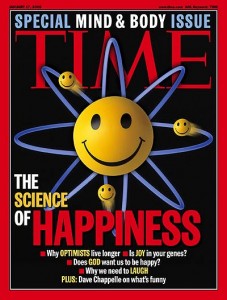For years, the scientific study of happiness focused mostly on the lack of it – unhappiness, depression, mood  problems. The study of happiness – what truly makes people happy and how they benefit from it – was always considered “fuzzy” or “touchy-feely” and unscientific. However, in the last decade or so, scientists and researchers have finally turned some serious attention to happiness and positivity. What they’ve learned should shape the way we live and lead.
problems. The study of happiness – what truly makes people happy and how they benefit from it – was always considered “fuzzy” or “touchy-feely” and unscientific. However, in the last decade or so, scientists and researchers have finally turned some serious attention to happiness and positivity. What they’ve learned should shape the way we live and lead.
For starters, everyone can be happier. Scientists have learned that some part of our happiness is innate. Some are just naturally happier than others and we all have a happiness “set point,” kind of like a golfer’s “handicap.” But they also found that everyone can exceed their set point – everyone can beat their happiness “par.” In that respect, it’s within almost everyone’s power to “choose” to be happier.
Almost everyone can improve happiness through what researchers like Sonja Lyubomirsky of Cal-Riverside call “intentional activity.” Her study for the National Institutes of Mental Health confirms some of the same strategies I’ve highlighted in books like the Fred Factor and Up, Down, and Sideways, namely that intentional behaviors and attitudes like kindness, gratitude, and optimism actually improve happiness. In other words, anyone can choose to act kindly, to practice gratitude, and to adopt an optimistic outlook and it will make them measurably happier.
According to the research, what does and doesn’t make us happy? Money? No, after you reach a $50-75K income or so, more money does not bring more happiness. Being attractive? No. Marriage? Yes. Social acceptance? Yes. Success? Not necessarily.
In fact, one of the most interesting findings in this research is that happiness leads to success more than success leads to happiness. As I shared in Up, Down, and Sideways, Shawn Achor’s Harvard research showed that 75% of the factors that predict career success are related to happiness and optimism. He found that optimists who see challenges as an opportunity to improve and who believe that their own behavior can make a difference were the most likely to succeed.
Leaders should take notice and many already have. Encouraging happiness among those you lead makes them more effective and successful. A recent Robert Half survey showed the number of executives who appreciate the importance of positive work environments and corporate culture has risen dramatically. Now, fully one-third of executives believe a positive work environment and a happy corporate culture are the top factors in employee engagement, satisfaction, and retention. That’s up from just one-tenth when the survey was first taken.
A researcher at the University of Nevada-Las Vegas showed how that translates to the front lines of customer service. He surveyed consumers who were served after waiting in line. Those served by positive and upbeat employees estimated their wait time to be shorter than it actually was. They believed they’d gotten faster service than they actually had because the service was happy!
What success and happiness have in common, according to much of this research, is that they both require us to maintain our “intentional activity” to sustain them. We find the most success and happiness when we are actively pursuing both. That’s the main finding of Shimon Edelman’s The Happiness of Pursuit, a study of the neuroscience of happiness. When we stop working at it, the happiness and success can dissipate.
In part two, we’ll take a look at the pitfall of success – what happens when we reach goals, our happiness plateaus, and we stop our pursuit and our “intentional activity.”







